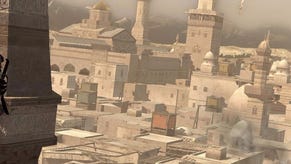The World of Assassin's Creed II
Digital Foundry's latest time-lapse.
Ubisoft's terrific Assassin's Creed II launched just yesterday and it really is something extraordinary - a game so impressive it's more than worthy of some special treatment at the hands of Digital Foundry. As discussed in this week's Face-Off, one of the key improvements made to the original Assassin's Creed engine was the addition of a full day/night cycle, and we were eager to test that implementation.
There's no better way to do this than by undertaking one of our painstaking, time-consuming, but really very cool time-lapse videos. Just a few special ingredients are required to put one of these together: the ability to go anywhere within the virtual world, a first-person view with no intrusive HUD, and finally, phenomenal amounts of patience. In truth, the biggest challenge with this one was keeping Ezio as still as possible (you might notice the odd bit of "wobble" on close objects where this wasn't possible).
What we have is a collection of 31 time-lapse locations, covering 10 days of in-game time across four cities, from the rustic charms of Florence through to the sheer beauty of Renaissance Venice. It's Assassin's Creed II as you've never seen it before and certainly won't see it elsewhere. In addition to the streaming options, there's a download version on the EGTV clickthrough, along with this mega-bandwidth version designed for playback on Xbox 360 and PS3.
It's intriguing to compare the virtual world Ubisoft Montreal has created with Rockstar North's incredible Liberty City, as seen in GTAIV. Both do a superb job in providing a fully immersive gameplay environment, but the two approaches - time-of-day lighting and shadowing aside - are very, very different. Rockstar has attempted a fully featured approximation of city life: a bewilderingly vast array of different AI behaviours for the characters, a full weather system, and of course implementation not just of NPCs, but also a complete range of vehicles too.
Assassin's Creed II seems to follow a different philosophy - the creation of environments that look incredible "in the moment", but don't really aspire to any lofty pretensions of creating a full-on simulation of life in 15th century Italy. Aside from their penchant to occasionally delve into your money pouch or engage you in rooftop chases, AI behaviour of the citizenry is unremarkably routine (those poor courtesans don't seem to get much "traffic"). Horses and vehicles aren't allowed within city limits. This "almost but not quite" approach also applies to the renderer too. The time-of-day lighting is quite superb, but the sky itself looks to be a simple 2D bitmap wrapped dome-like around the environment with a layer of atmospherics overlaid on top. It's an example of how compromise only really manifests when the engine is put through extraordinary scrutiny (as time-lapse video is wont to do). In-game it just works and looks great.
The core tech within Assassin's Creed II is very similar to that seen in the first game, which at the same time proves just how far ahead of the curve Ubisoft Montreal was in 2007, but makes the slightly dodgy performance stand out somewhat in the present day.
However, aside from the implementation of the day/night cycle, there have been other improvements too. The developers have rarely discussed the new "Scimitar" engine for ACII with the press, but mooted additions have included improved lighting and reflections (essential for the spectacular Venice cityscape, obviously), while the vegetation generation system pioneered in Far Cry 2 also gets ported over for inclusion within the revised tech. Ubisoft Montreal has also made headway in improving the level of detail (LOD) levels with new streaming tech that resolves higher-quality art further away in the distance.
However, the limitations of the original AC1 tech do manifest, most notably in the cascading shadowmaps within the game. Detail level of shadowing changes dramatically at set points ahead of Ezio, most noticeable in the video at around the 00:57 mark, where shadowing on the central tree is divided half and half between higher and lower resolution renderings. Noticeable geometry popping (scenery appearing from nowhere) is also another issue that is reminiscent of performance in the first Assassin's Creed and still manifests even after hard-drive installation.
Ubisoft's technical achievement here is still sizeable, but if you're thinking that the scale and diversity of this open world causes issues in terms of storage space available on Xbox 360, think again. Assassin's Creed does indeed effectively max out the available DVD space, but whereas some publishers release different game variations with support for individual languages, ACII features full audio support for English, French, German and Italian on the same disc. Each of those sound packs takes up around 200MB of space on the DVD, and over and above that, there's also another 100MB spent on a trailer for the forthcoming Ubi/James Cameron Avatar game. It's also interesting to note that the PS3 version of the game occupies pretty much the same area too.
In one sense it highlights the excellent levels of compression that Ubisoft Montreal achieved in ACII, but on the other, it does rankle slightly that one of the annoyances of the original game - repetitious dialogue from the citizenry - once again rears its ugly head in the sequel. It's an element that we would really like to see improved in the sequel.
Ubisoft is on the record as saying that Assassin's Creed will be a trilogy of games, so it will be interesting to see where the developer is heading for the next title, and whether the existing engine will stand the test of time for a third outing - presumably in 2011, when the current HD consoles will be well into their twilight years. The sheer volume of content in ACII, and the fact that the game itself is simply so utterly cool more than mitigates any of the technical shortcomings in the here-and-now. But come AC3, we can't help but wish for the complete package.









